
Photo: Disney
Welcome to Revisiting Disney! This week, we’re looking at a Disney movie with so many catchy songs, Frozen! Like always, I have labeled each category so if you want to skip to the parts that interest you most, feel free. And, of course, if you have any thoughts, burning or otherwise, please share in the comments!
BACKGROUND OF FROZEN
Released on November 27th, 2013, Frozen is the Disney movie that made me, personally, think that the Disney I remembered from my childhood was back. I loved The Princess and the Frog, Tangled, and Wreck-It Ralph, and the appearance of Frozen, another solid addition to the Disney lineup (and one that was very popular).
When it first came out, I thought it might be the best Disney movie since The Lion King. Now, I would say that that probably isn’t true, but it might be in the running for one of the most successful animated features to be released by Disney. On its opening weekend, it made about $67 million dollars, and almost made $401 million during its initial theatrical release.
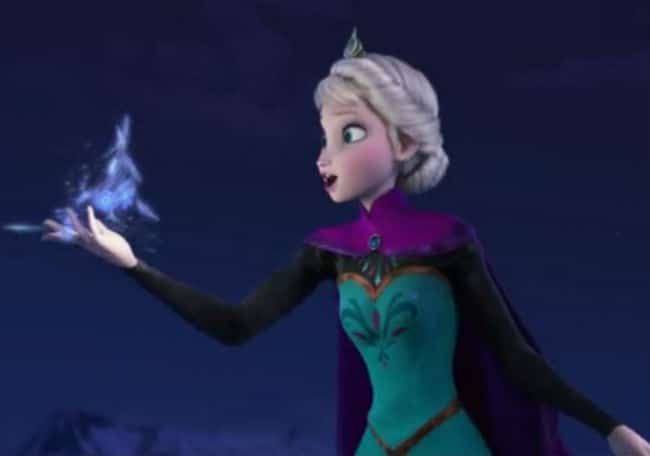
Photo: Disney
Frozen was the first Disney full-length animated feature film to win an Academy Award since Tarzan won in 2000. It was also the first Disney (not Pixar) animated film to win the Academy Award for Best Animated Feature Film, and the first Disney animated film to win more than one Academy Award since Pocahontas did in 1996.
Like I said, Frozen won the Academy Award for Best Animated Feature Film of the Year in 2014. It was directed by Chris Buck, Jennifer Lee, with Peter Del Vecho as the producer. The screenplay was written by Jennifer Lee, and the story was developed by Chris Buck, Jennifer Lee, and Shane Morris. Del Vecho served as producer on Winnie the Pooh, and The Princess and the Frog, while working as an associate producer on Chicken Little and Treasure Planet. Chris Buck worked in the story department of Pocahontas, wrote the screenplay for Surf’s Up, and had previously directed Tarzan and Surf’s Up.
Jennifer Lee wrote the screenplay for Frozen, was one of the writers of the screenplay for Wreck-It Ralph, and also wrote the screenplay for the upcoming film, A Wrinkle in Time. She also worked on the story for Zootopia, and is directing the upcoming Frozen 2. She is listed as the first woman to direct a Disney full-length animated film. She is also the only woman that has written a screenplay (on her own) for a Disney animated film since Linda Woolverton wrote the screenplay for Beauty and the Beast in 1991.
Frozen has been claimed by some to be a groundbreaking story, and honestly, I can see it. I know, it’s not the first Disney movie to have a strong female character who can fight and doesn’t need a man to save her (Mulan), a character who becomes a Queen by the end of her film (Kida from Atlantis: The Lost Empire), a focus on family (Lilo & Stitch and Brother Bear), a non-conventional love story and romantic lead (The Hunchback of Notre Dame), criticizing the idea of marrying someone after only knowing them for a day (Enchanted), the idea that your first love might be the wrong man (Hercules), and challenges the idea that marriage isn’t the only ending for a movie (Brave, even though it’s technically Pixar), but it does address all of these things in the same movie.
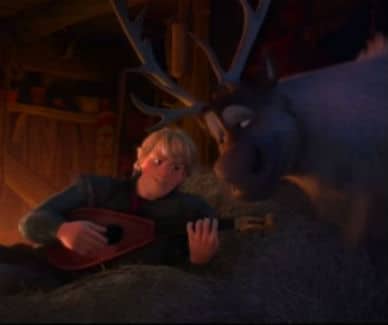
Photo: Disney
I think that Frozen, and Jennifer Lee, should get credit for addressing all of these tropes in one go, and in a very effective way. Plus, there are two main female characters with very different story arcs, and I found myself invested in both of their stories. For all of this, I think, Frozen deserves to be praised.
MUSIC OF FROZEN
In addition to the Oscar and Golden Globes for best Animated Feature Film, Frozen also won the Oscar for Original Song (“Let It Go”), performed by Idina Menzel. The songs in Frozen are wonderful. They’re written by Tony, Grammy, Emmy, and Oscar-winning Robert Lopez and his wife Kristen Anderson-Lopez, the team that brought us the Broadway musicals “Avenue Q” and “The Book of Mormon.”
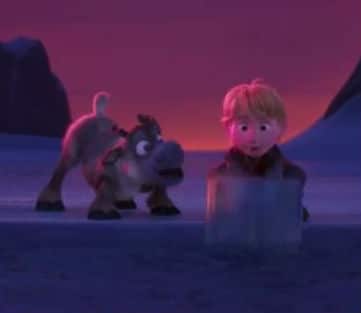
Photo: Disney
The rest of the music is by Christophe Beck, who also was involved in the film Pitch Perfect. His list of films is pretty long, so I won’t list them all here. However, the important thing about the Frozen score is that it’s epic in all the right places while knowing when to dial back. Overall, the music fits the mood of the story; the score takes bits of the songs and weaves them in.
The characters are performed by Tony-winning actress Idina Menzel, Tony-nominated actor Jonathan Groff, Tony-nominated actor Josh Gad, Santino Fontana, and multi-award winning Kristen Bell (both of whom have performed on Broadway). Basically, it was a star-studded Broadway cast, which is appropriate. Frozen is basically a movie musical that happens to be animated.
ANIMATION
Frozen is a CGI film and one that certainly takes advantage of the technologies it can use. As I was digging into the animation of Frozen, I discovered something very interesting. Apparently, applying fractal mathematics to CGI backgrounds helps these look more realistic. This technology makes the setting of Frozen, and other CGI films, look more realistic and three-dimensional. The snow castle, in particular, is an amazingly animated building and one that took over forty animators nine months to finish. The film itself had a team of 600 and took two and a half years to finish.
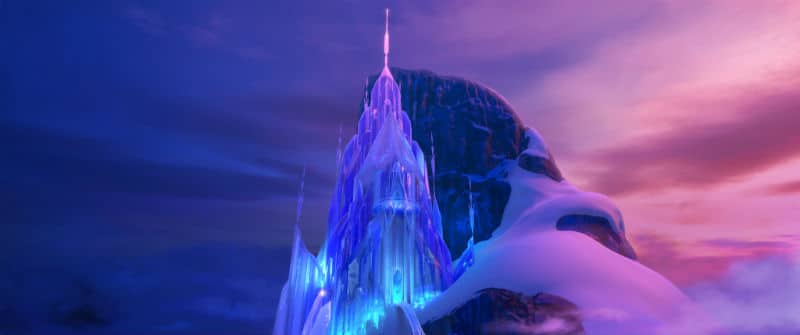
Arendelle, the setting for Frozen, is based on the Scandinavian country of Norway. The team had gone on a two-week long research trip to Norway before they began to make Frozen. The team took their ideas on the clothing, music, architecture, and landscape of the film; with the castle being inspired by Akershus Fortress in Oslo, Arendelle’s town was inspired by Bryggen (a city on the west coast), and the surrounding area by the Naeroyfjord.
The art director of Frozen, Michael Giaimo, had previously worked as the art director for Pocahontas and also worked on Home on the Range (which was not a critical or popular success; apparently, there were layoffs in the Disney Studios after it, it went so badly). Giaimo’s design for Frozen was inspired by Mary Blair’s work in Cinderella and Peter Pan, as well as the work of Eyving Earle in Sleeping Beauty.
Giaimo talks about three things that he and the team used in the art design of Frozen that they learned in Norway. They used the fjords, the triangle lines of roofs and shingles of medieval Norwegian architecture, and rosemaling folk art.
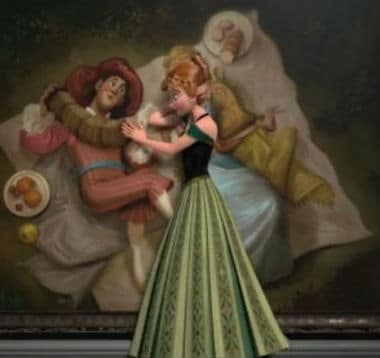
Photo: Disney
Rosemaling is a decorative folk art. It involves decorative painting of ornamental flowers, scrollwork, linings, and geographic elements onto wood, typically in flowing patterns. This can be seen in the architecture, décor, and the costumes of Frozen. The costumes are some of the most elaborate in a Disney film, and the dresses have pleats. And the pleats act like pleats in actual dresses! It was a really cool touch, and I love it.
Like in other animated films, a live reindeer was brought into the Disney Studio, so that the Disney animators could draw Sven in a realistic way. I also was very interested in learning that the animator of Olaf, Lino DiSalvo, did the initial animation of Olaf in the traditional hand-drawn style, and then transferred it to his CGI character.
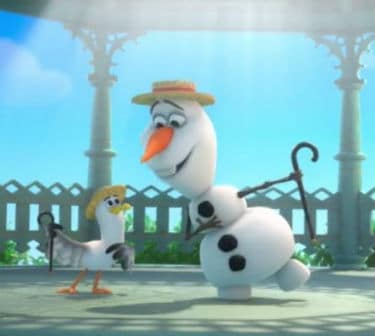
Photo: Disney
PLOT
Frozen opens with ice harvesters and a catchy musical number that warns us to “beware the frozen heart.” I bet that will come back later on in the film. There is also this tiny kid and his reindeer, who I’m sure aren’t important either.
We then see the little princesses, Anna and Elsa, playing with snow in the castle. Elsa has ice powers, you see, and the two have a ton of fun in the ballroom (sledding, building snowmen, and so on). Unfortunately, Anna falls and when Elsa tries to catch her, accidentally sends a bolt of her winter magic into her sister’s head. We also learn that Elsa’s powers are very triggered by her moods, which is fair, she’s still a kid.
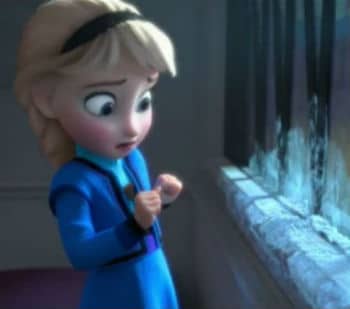
Photo: Disney
Luckily, their parents know that the trolls can heal Anna’s head. Unluckily, they remove Anna’s memories of Elsa’s powers and warn her that fear is her enemy. So, of course, in an attempt to protect her, Elsa’s parents keep her isolated until she can control her powers (conceal, don’t feel). Therefore, Elsa grows up isolated and afraid of both her powers and hurting the people she cares about, while Anna is a bubbly kid who doesn’t understand why her sister hates her.
Tragedy strikes and the girls are left without their parents. When it comes time for Elsa to be crowned on her 21st birthday, she is terrified about revealing her powers, while Anna is thrilled to have a coronation ball and maybe fall in love. The coronation goes according to plan, but when Anna is smitten by the dashing Prince Hans and asks to marry him, she and Elsa argue.
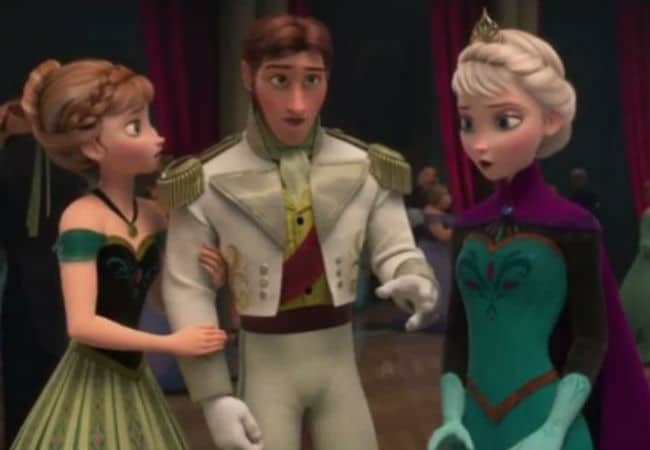
Photo: Disney
This triggers a reveal of Elsa’s powers, and she is horrified, running off to a place where she can’t hurt anyone. Unknown to her, this event sets off an eternal winter in Arendelle. Traveling with Kristoff, the kid from the beginning, Sven the reindeer, and Olaf the snowman, Anna sets off to find her sister and make things right . Of course, nothing is as it seems, and Anna and Elsa must repair their relationship, and deal with their own inner demons before the seasons can be brought back into balance.
Will Elsa learn to control her powers? Is Hans Anna’s true love, or is Kristoff? Can Elsa and Anna ever just talk? Will Elsa even want to come back to Arendelle? Will Anna be successful in her quest? How did Elsa get her powers, anyway? Most of these questions will be answered in Frozen.
SOURCE MATERIAL
Frozen is based, very loosely, on the Hans Christian Andersen fairytale, “The Snow Queen.” Loosely, very loosely (but I’ll come back to that). Disney had been trying to adapt “The Snow Queen” since the early 2000s, first in 2002 with Glen Keane and then again in 2009 with the directing, writing, and musical team from Beauty and the Beast (Kirk Wise, Gary Trousdale, Don Hahn, Linda Woolverton, Alan Menken, and Glenn Slater-from Home on the Range).
Like in 2002, this 2009 adaptation didn’t work out, but instead of completely tabling the story, they put it on hold until the Studio could figure out how to adapt the story. Personally, as much as I love Frozen, I am very interested to see what this 2009 story would have looked like.
Originally, Elsa was going to be the villain of Frozen, but when the production team heard the song “Let it Go,” they thought it was too positive and had too many positive values to be a villain song. This then caused the story to be changed, making Elsa more of an isolated character who is struggling with her powers and the fact that she could hurt the people she loves.
The original fairy tale “The Snow Queen” is made up of seven stories, each wonderful and full of adventure. The first story is about a magic mirror that a goblin has twisted to distort the truth. When the mirror shatters, the shards hit Earth. When the shards land in someone’s eye, they can only see the ugliness in the world, and when a shard lands in someone’s heart, their heart froze solid.

Photo: Disney
Our story then shifts to a little boy and girl named Kay and Gerda, who are best friends and neighbors. When Kay gets a piece of the mirror in his eye and heart, his personality changes (and not for the better); he is later saved from freezing to death by the Snow Queen, who takes him north with her. Here, he forgets his family and Gerda.
Gerda, when she hears that Kay is gone and that he has gone away, is very upset. Thinking that he has drowned, she offers the river her shoes for Kay and accidently falls asleep in the boat. This starts off her adventures, and Gerda’s quest to find Kay. She falls under the spell of summer, meets the Lapland Woman, the Finland Woman, the Robber Maiden, the Raven, and the Reindeer, among others, before arriving at the Snow Queen’s palace to save Kay.
It’s one of my favorite fairy tales, and I have yet to see the perfectly cast miniseries, chronicling all of Gerda’s adventures on her quest to save her friend, that I would like to see. There are quite a few foreign films that I want to check out that look promising, though. If anyone knows of a great adaptation of the original, let me know in the comments!
The 2000’s
In the new millennium, there was an increase in technologies, particularly in the increase of high-speed internet. The rise of various technologies also led to the world becoming smaller; news travels so much faster now than it ever has before. It was interesting to learn during my research that some of the worst natural disasters in our history happened during the beginning of the new millennium, including Hurricane Katrina, an earthquake and tsunami in the Indian Ocean, and an earthquake in Kashmir.
In 2013, Lance Armstrong admitted that he had been using drugs when he won all of his Tour de France races. A meteor exploded near Chelyabinsk (Russia), killing over one thousand people, and on April 15th in the United States, two bombs exploded at the Boston Marathon, killing three people and wounding over two-hundred and fifty. North Korea continued to test nuclear weapons, despite the very stern disapproval of the UN, there was a terrible tornado in Oklahoma, and an earthquake in Italy.
Additional things happening in the United States this year include the security breach at Target, the NSA PRISM Leaks, and Edward Snowden, and the United States Government almost shut down, but agreed on a quick last-minute deal that kept it open.
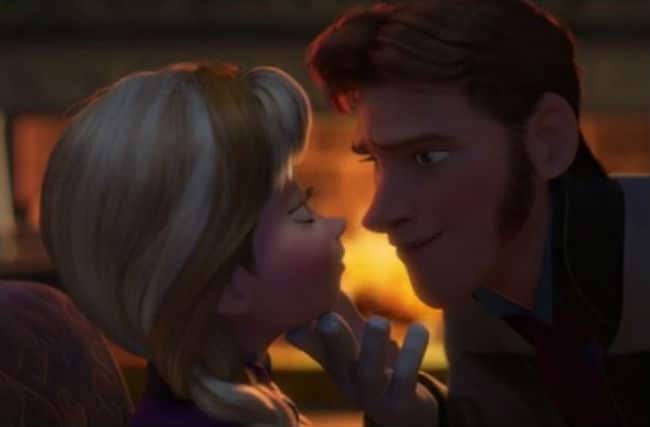
Photo: Disney
It was a rough year, both at home and in the rest of the world. This might be a part of the appeal of Frozen; it looks at the bonds that hold us together, rather than the things that tear us apart. It also reminds us that things aren’t always what they seem, sometimes the villain is who we least expect, or, at least, reminds us to be vigilant. In a world where information is transmitted so quickly, this is a good lesson to remember.
LESSONS LEARNED
According to Grandpabbie the Troll, “the heart is not easily changed, but the mind can be persuaded,” so basically, you can learn new things, but it’s hard to change a heart. They’re usually pretty fixated on something, so it takes more work to change a heart than a mind. Also, minds can be persuaded with logic, while hearts tend to defy logic.
Another lesson from Frozen is that you can’t marry a guy you just met! Maybe know someone for longer than a day before you decide you’re spending the rest of your life together?
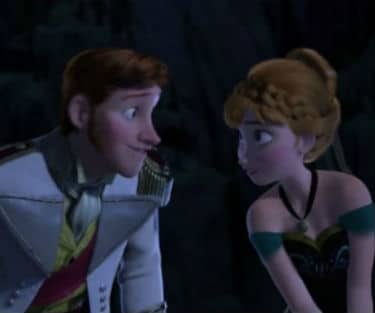
Photo: Disney
With that, there is also the idea that your first love might not be a true love, and be careful who you give your heart to. Not everyone that you meet is trustworthy, and sometimes it can be hard to tell at first. This doesn’t just apply to love; it also applies to life in general.
A fourth lesson is that family is important. The relationship between family is one of the most important bonds that we have and one that needs to be nurtured and cherished. Anna and Elsa both have very different personalities, but that doesn’t mean that they love each any less. True love can be found in romantic relationship, but also in family relationships; it’s different but still valid.
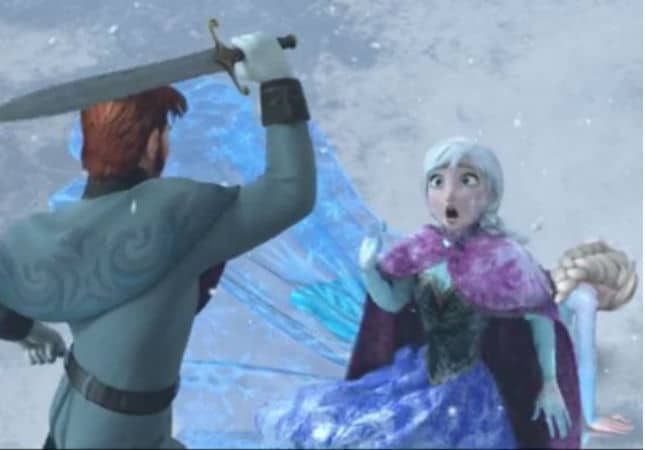
Photo: Disney
The fifth lesson in Frozen is that it’s okay to be yourself. Everyone has quirks, and we need to acknowledge them and move on. Of course, it’s likely that no one has a quirk that could accidentally kill someone or start an eternal winter, but still.
Sixth, you can’t change the people you love because people don’t change, but love brings out the best in people.
Seventh, people make bad choices, when they’re mad or scared or stressed.
Eighth, we all have responsibilities, and even if it’s hard to face our inner demons, we need to. Elsa reminds me a lot of Simba in that way, actually; both of them were running from something (his past, her powers), that they knew could hurt their families. In the end, they realized that they were stronger than they thought and that they had a responsibility to their people. Their people needed them, and although they had to figure themselves out first, both eventually took up their responsibilities. Because of their struggles, they were better rulers, and better “people” (Simba is a lion, I know, but the point stands).
Finally, all the seasons are beautiful in their own ways, and they all work together to create a year. People are also like that, it takes a variety of us to make the world.
Also, less of a lesson and more of a Frozen PSA, anxiety is real and can affect everyone, even a Queen. If you think you have it, it’s nothing to be ashamed of. There are ways to live with it. Frozen also has a strong message of girl power; girls can save the day, just like boys can.
DOES IT HOLD UP?
Okay, first off, Frozen is not a good adaptation of “The Snow Queen,” because, well, it’s not the same story. However, it is a wonderful film that broke a ton of Disney stereotypes, while still paying homage to the Disney films and traditions that it comes from. It’s clever and funny, the animation is gorgeous, and the music is very catchy. If you haven’t seen Frozen, I’m surprised you managed it (and sorry about the spoilers); it’s definitely a film worth checking out.
For next week: Big Hero Six
If you enjoyed this post and the others in the Revisiting Disney series, and have found yourself wishing that you could find them all in one convenient and bound book with eight extra essays, there is an option for you! Check out A Journey Through Disney: My Look Back Through Disney Canon, now available on Amazon as both a Kindle book ($4.99) and a paperback ($11.99).
OTHER SOURCES:
https://thewaltdisneycompany.com/about-disn-ey/disney-history
http://www.imdb.com
http://studioservices.go.com/disneystudios/history.html
http://www.thepeoplehistory.com
Bailey, Adrian. Walt Disney’s World of Fantasy. Everest House Publishers. New York, New York. 1982.
Finch, Christopher. The Art of Walt Disney: From Mickey Mouse to the Magic Kingdom. Harry N. Abrams, Inc. New York, New York. 1975.
Johnston, Ollie and Frank Thomas. The Disney Villain. Hyperion. New York, New York. 1993.
Thomas, Bob. Disney’s Art of Animation From Mickey Mouse to Hercules. Hyperion. New York, New York. 1992.
ARE YOU A ROMANCE FAN? FOLLOW THE SILVER PETTICOAT REVIEW:
 Our romance-themed entertainment site is on a mission to help you find the best period dramas, romance movies, TV shows, and books. Other topics include Jane Austen, Classic Hollywood, TV Couples, Fairy Tales, Romantic Living, Romanticism, and more. We’re damsels not in distress fighting for the all-new optimistic Romantic Revolution. Join us and subscribe. For more information, see our About, Old-Fashioned Romance 101, Modern Romanticism 101, and Romantic Living 101.
Our romance-themed entertainment site is on a mission to help you find the best period dramas, romance movies, TV shows, and books. Other topics include Jane Austen, Classic Hollywood, TV Couples, Fairy Tales, Romantic Living, Romanticism, and more. We’re damsels not in distress fighting for the all-new optimistic Romantic Revolution. Join us and subscribe. For more information, see our About, Old-Fashioned Romance 101, Modern Romanticism 101, and Romantic Living 101.

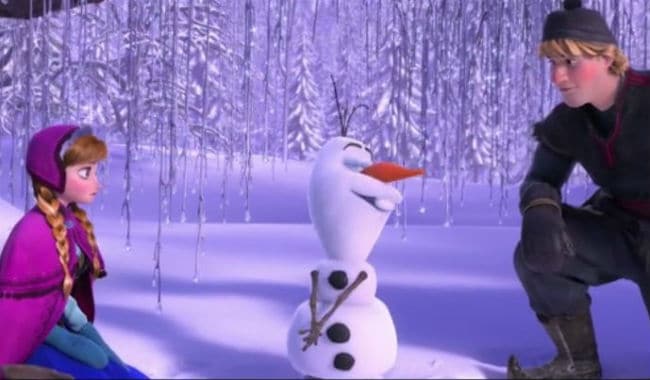
A Disney FAVORITE in my book. I love the bond between sisters, the music and animation style to say nothing of Olaf’s adorableness (and the vocal talent!).
It is a really fun one, though I would love a faithful adaptation of “The Snow Queen” someday. “Frozen,” though, really cemented to me that Disney is back. Things are looking good again! And the vocal talent is incredible!